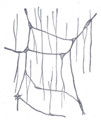Enteric nervous system facts for kids
The enteric nervous system (ENS) is like your body's "second brain." It's a special network of nerves found right in your gut. This amazing system helps control how your digestive system works, almost all by itself! It's a key part of your nervous system, which sends messages all over your body.
Contents
Your Gut's Own Brain
The enteric nervous system (ENS) is a huge group of nerve cells that live inside the walls of your stomach and intestines. It's part of your peripheral nervous system, which includes all the nerves outside your brain and spinal cord. Think of it as a mini-brain just for your gut!
This system is so important that it can work on its own. It doesn't always need to get messages from your main brain. This is why some scientists call it the "second brain" or "gut brain."
What Does the ENS Do?
The ENS has a very important job: it controls your entire digestive system. It manages many different actions, such as:
- Moving food through your gut.
- Mixing food with digestive juices.
- Controlling blood flow to your stomach and intestines.
- Protecting your gut from harmful things.
It does all this through special actions called reflexes. These are automatic responses that happen without you even thinking about them. For example, when you eat, your ENS automatically starts the process of digestion.
How Does the ENS Work?
The ENS has millions of neurons, which are nerve cells. In fact, it has more neurons than your spinal cord! These neurons are organized into two main networks, or "plexuses," within the walls of your digestive tract:
- Myenteric plexus: This network is found between the muscle layers of your gut. It mainly controls the movement of food.
- Submucosal plexus: This network is found closer to the inner lining of your gut. It helps control blood flow and how your gut absorbs nutrients.
These two networks work together to make sure your digestion runs smoothly. They send signals back and forth, telling different parts of your gut what to do.
Moving Food Along
One of the ENS's main jobs is to make sure food moves through your digestive system. It does this using a wave-like motion called peristalsis. Imagine squeezing a tube of toothpaste from the bottom up. That's similar to how your gut muscles push food along! The ENS controls these muscle contractions, making sure food travels from your esophagus to your stomach, then to your small intestine, and finally to your large intestine.
Chemical Messengers
The ENS uses special chemical messengers called neurotransmitters to send signals. These are the same types of chemicals used in your brain. For example, serotonin is a neurotransmitter that helps control gut movements and feelings like hunger. This is why your gut can sometimes affect your mood!
The ENS and Your Main Brain
Even though the ENS can work independently, it also communicates with your main brain. This connection is part of the autonomic nervous system. The autonomic nervous system controls things your body does automatically, like your heart rate and breathing.
The ENS and your brain send messages to each other through the vagus nerve. This connection helps your brain know what's happening in your gut. It also allows your brain to influence your digestion, especially when you're feeling stressed or nervous. This is why you might feel "butterflies" in your stomach when you're anxious!
Why is the ENS Important?
A healthy ENS is vital for good digestion and overall well-being. When the ENS isn't working correctly, it can lead to digestive problems. Scientists are still learning a lot about the ENS. They hope to find new ways to help people with digestive issues by understanding this amazing "second brain" better.
Images for kids
-
Layers of the Alimentary Canal. The wall of the alimentary canal has four basic tissue layers: the mucosa, submucosa, muscularis, and serosa.
See also
 In Spanish: Sistema nervioso entérico para niños
In Spanish: Sistema nervioso entérico para niños





